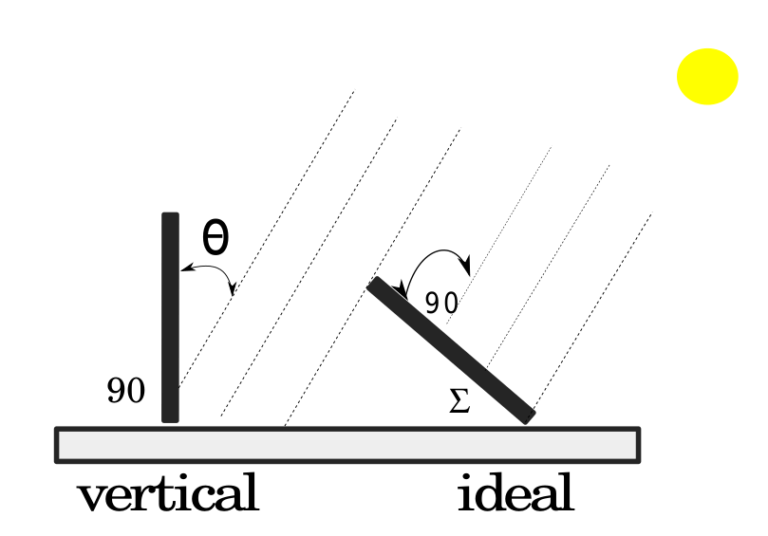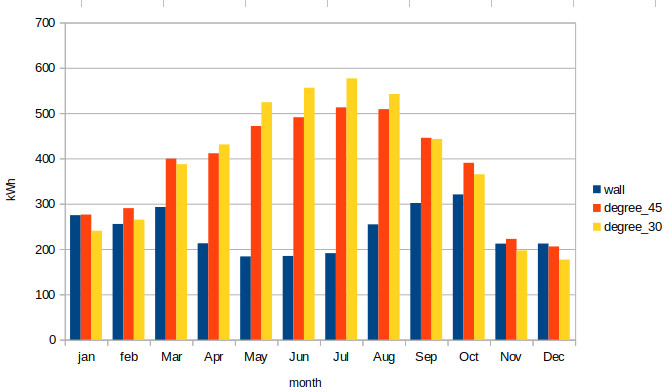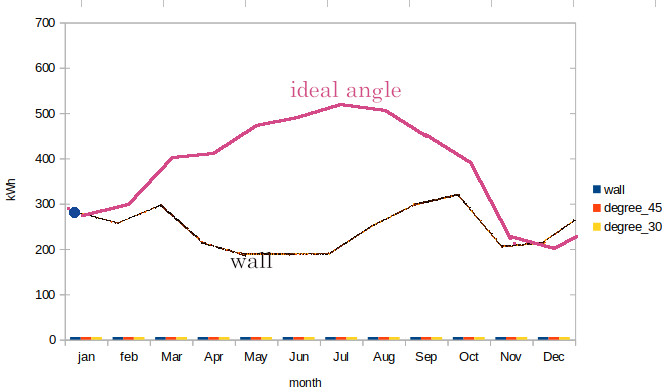We can often see offers for the installation of solar panels on building facades. What is hidden behind it and how profitable it is, I will analyze with the SPAC application intended for the calculation and forecasting of profit from solar panels.You can often see offers for the installation of solar panels on building facades. What is hidden behind it and how profitable it is, I will analyze with the SPAC application intended for the calculation and forecasting of profit from solar panels.
The Innovative Edge: Solar panels on vertical walls
Solar panels on the walls of buildings. At first glance, an unused area is the right place for mounting solar panels. If we go by the logic that every free space in the urban environment should be used to collect solar energy, then OBO is a real mine of pure free energy. Many facades of buildings and solitaires in large cities facing partly south unnecessarily absorb sunlight and heat the walls. The walls absorb sunlight, which could be used to generate electricity. The walls can use this amount of light to generate electricity. In further consideration, I will do some comparative calculations with the SPAC application to see what we can expect.
Benefits of using vertical spaces for solar energy capture
The task of this post is to find out the benefits of installing solar panels vertically, that is, on the walls of buildings or houses. For optimal solar energy production, the panels must be installed on a south-facing wall free from any shadow cast by surrounding buildings. If there is a larger building in the neighborhood, it is impossible to use the wall as a source of solar energy. I am referring to the east-south-west route. If there is a lower building on the same stretch, it is again impossible to completely pave the facade because the smaller building will cast a shadow on the lower parts of the building. Sunlight falls on the earth at an azimuth angle of 0 to 110 degrees, depending on latitude and time of day. In principle, azimuth angles are small during winter, so we say that “the sun is low.” In summer, these angles are larger. Winter conditions favorably affect the geometry of vertically mounted solar panels. The angle of incidence is then closer to the perpendicular angle to the panel, which is advantageous. In the summer months, the situation is the opposite. The attached calculation example below demonstrates this.

Case studies of successful vertical panel implementations
I will begin the analysis of an ideally placed building whose walls face south. Assume no adverse shadowing effects from surrounding buildings or trees. We will choose for the test the latitude of the city of Chicago and 10 solar panels with a power of 400 W, as I have done before for various tests. I will then compare the obtained results with favorably inclined panels at 45 and 30 degrees. I will calculate the gain from solar on a monthly and summarized yearly basis.
More information on the ideal solar panel angle can be found here.
First, let’s enter the data:
Orientation to the south: 0 degrees, pointed to the south
Panel tilt angle: 90 degrees (vertical setting).
Position: Ground
Solar panels: 10×1 in array: JA JAM54S30-400/MR 400W
I will vary the value of the inclination of the panel: 45 degrees and 30 degrees.
After three calculations, the total monthly and annual profits look like this:
| Angle | Jan | Feb | Mar | Apr | May | Jun | Jul | Aug | Sep | Oct | Nov | Dec | SUM | |
|---|---|---|---|---|---|---|---|---|---|---|---|---|---|---|
| 90 | 274.8 | 255.3 | 292.8 | 212.8 | 183.7 | 184.7 | 190.9 | 254.5 | 301.5 | 320.5 | 211.9 | 212.2 | 2895.5 | |
| 45 | 276.1 | 290.2 | 399.6 | 411.3 | 471.6 | 491.0 | 512.8 | 508.7 | 445.5 | 390.3 | 222.5 | 205.7 | 4625.2 | |
| 30 | 240.4 | 264.9 | 387.4 | 430.9 | 524.1 | 556.0 | 576.7 | 542.1 | 442.9 | 364.9 | 197.0 | 176.9 | 4704.1 |
Interesting facts: In December, gain from vertical is bigger than gain from the ideal. Unfortunately for vertical, December has a short day of light. In January gain from vertical is almost equal as ideal panel angle.

If we look more closely, we can see that the annual change in solar gain with conveniently placed panels is linear. With panels on vertical walls, the diagram looks different.

Three more interesting details
Reflected and diffuse components
Ideally placed solar panels are not exactly champions at capturing the reflected component. With panels placed vertically on the walls, the situation is much more favorable. The situation is similar with the diffuse component. For example, in January, when the sun is low and the angle of incidence is favorable, the direct component is dominant, the diffuse component is 3%, and the reflected component is 4%. In June, when the sun is higher and the angle is unfavorable for the direct component, the gains from the diffuse component amount to 15% and from the reflected component, 12% of the total collected energy.

Monthly incident angle at solar noon
It is a real pity for vertically mounted components that the days are shorter in winter. A low sun has a geometrically favorable effect on vertical panels. However, other factors also have an influence, mainly irradiation and the length of the day. In any case, the flow of the function looks like this: Maximum gain in March, then starts a sharp decline to reach the minimum in May and June. Then it grows again until October, when it reaches its maximum value. Then there is a decline in November and December, and from January on, the growth reaches its maximum. We can conclude that there are two maxima at the beginning of spring and at the beginning of autumn. The second one is bigger.

Monthly energy gains, ups and downs
The fluctuation of monthly gains and losses occurs throughout the year. The highest energy gain was in January (62.55 kWh) and in August (63.54 kWh). The biggest drops are in April at 79.98 kWh and in November at 108.54 kWh.



